
Evanston is a city in and the county seat of Uinta County, Wyoming, United States. The population was 11,747 at the 2020 census. It is located near the border with Utah.
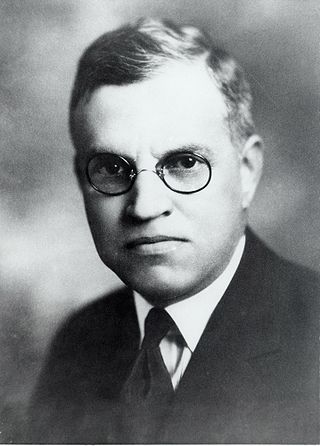
Robert Chambers Reamer (1873–1938) was an American architect, most noted for the Old Faithful Inn in Yellowstone National Park. A number of his works are listed on the National Register of Historic Places for their architecture.

Piedmont is a ghost town located in Unita County, Wyoming, United States. It was once a thriving small railroad and timber town, but started to decline when Union Pacific opened a new line that bypassed the town.
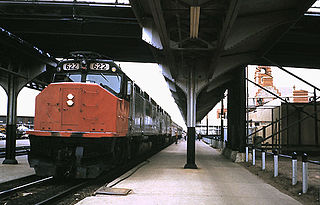
The Cheyenne Depot Museum is a railroad museum in Cheyenne, Wyoming, United States. It is located inside the 1880s Union Pacific Railroad depot. A National Historic Landmark, the station was the railroad's largest west of Council Bluffs, Iowa, and a major western example of Richardsonian Romanesque architecture.

The Louis Sawyer House is a historic residence in the city of Wyoming, Ohio, United States. Erected at the turn of the twentieth century, it was originally the home of an important lawyer, and it has been designated a historic site because of its architecture.

Oxford station was a historic train station at South Elm and West Spring Streets in Oxford, Ohio. Oxford first received railroad service in the 1850s, when a line connecting the Chicago and Cincinnati rail networks was completed through the city. The original station was replaced by a larger building in 1895. Before the rise of the automobile, the station's passenger services brought students to and from Oxford's multiple colleges, including Miami University, and its freight services shipped local agricultural products to their markets. A building known as the Junction House, located across the street from the depot, was built in 1860 and is closely associated with the railroad. Originally a grocery store, it became a hotel and tavern in 1868; while a local temperance movement closed the tavern in the 1870s, it remained a hotel until 1905 and is now an apartment building.

The Frances Willard House is a historic house museum owned by the National WCTU and is a National Historic Landmark at 1730 Chicago Avenue in Evanston, Illinois. Built in 1865, it was the home of Frances Willard (1839-1898) and her family, and was the longtime headquarters of the Woman's Christian Temperance Union (WCTU). Willard called the house Rest Cottage because it became a place for her to rest in between her tours and WCTU activities.
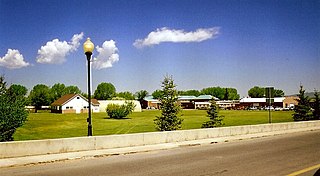
The Wyoming State Hospital, once known as the Wyoming State Insane Asylum, is located in Evanston, Wyoming, United States. The historic district occupies the oldest portion of the grounds and includes fifteen contributing buildings, including the main administrative building, staff and patient dormitories, staff apartments and houses, a cafeteria and other buildings, many of which were designed by Cheyenne, Wyoming architect William Dubois. Established in 1887, the historic buildings span the period 1907-1948. At one point it was common for new hall additions to be named after the counties in Wyoming. The recent addition of Aspen, Cottonwood, and Evergreen halls do not follow this trend.
The Redick Lodge, also known as the Chambers Lodge, is a private seasonal retreat on Upper Fremont Lake near Pinedale, Wyoming in the Wind River Range at an elevation of 7,500 feet (2,300 m). The lodge was designed by architect Otis Miller of Miles City, Montana as a log cabin on a stone foundation for George M. Redick, a Nebraskan who had worked with the Union Pacific Railroad on potential locations for company hotels. The Redick family spent summers at the lodge from 1918 through 1931, when family fortunes declined. The property was purchased by Dr. Oliver Chambers of Rock Springs, Wyoming in 1938 and has remained in the Chambers family.

The Evanston Main Post Office in Evanston, Wyoming was built in 1905 as part of a facilities improvement program by the United States Post Office Department. The post office in Evanston was nominated to the National Register of Historic Places (NRHP) as part of a thematic study comprising twelve Wyoming post offices built to standardized USPO plans in the early twentieth century. It was NRHP-listed as U.S. Post Office-Evanston Main.

This is a list of the National Register of Historic Places listings in Uinta County, Wyoming.
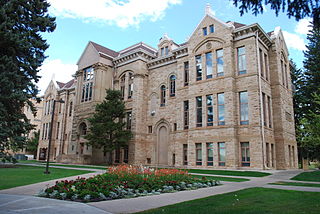
Old Main, built 138 years ago in 1886 in Laramie, Wyoming, was the first building on the University of Wyoming campus and continues as its oldest. At an approximate elevation of 7,180 feet (2,190 m) above sea level, it currently houses university administration.
The Brigham Young Oil Well is an oil seep near Evanston, Wyoming, United States that was discovered and used by the original Mormon expedition to Utah under the leadership of Brigham Young. The party used the oil on the surface to lubricate wagon wheel hubs, as polish, and as a poultice. After the party reached Great Salt Lake, a group returned and dug a well at the seep for other pioneers. The well served until 1869 when the Union Pacific Railroad brought petroleum to Salt Lake City.
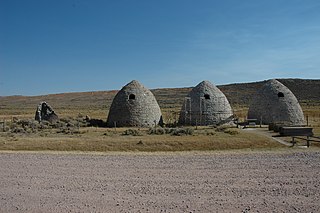
The Piedmont Charcoal Kilns in Piedmont, Wyoming, are a remnant of a once-extensive charcoal-making industry in southwestern Wyoming. The kilns were built by Moses Byrne around 1869 near the Piedmont Station along the Union Pacific Railroad. The three surviving beehive-shaped kilns were built of local sandstone about 30 feet (9.1 m) in circumference and about 30 feet (9.1 m) high, with 24-inch-thick (61 cm) walls. A granite marker reads:
Charcoal Kilns were built by Moses Byrne, 1869, to supply the pioneer smelters in the Utah Valley.

St. Paul's Episcopal Church in Evanston, Wyoming is a small church in the Carpenter Gothic style. The church was built in 1884–1885, and at the time was the only Protestant church in a community dominated by Mormons and Catholics. In its early history it hosted Lutherans, Methodists and Presbyterians in addition to its Episcopalian congregation.

The Downtown Evanston Historic District in Evanston, Wyoming includes about sixty buildings in a compact downtown commercial district.

The Union Pacific Railroad Complex in Evanston, Wyoming, was built to serve the Union Pacific Railroad main line running through Evanston. The complex's brick buildings were built in 1912–13, with frame buildings spanning the period from 1871 to the 1920s. The complex features a roundhouse with 27 stalls built during the 1912 improvement phase, replacing an earlier roundhouse built in 1871. The complex was the chief service point on the UP main line between Ogden, Utah, and Green River, Wyoming.

The Nevada-California-Oregon Railway Co. General Office Building, commonly known as the N.C.O. Building, is a historic site in Alturas, California, listed on the National Register of Historic Places. It was built 1917–1918 to serve as the headquarters of the Nevada-California-Oregon Railway. It has been an Elks Lodge since at least 1974.

The Woman's Christian Temperance Union Administration Building is a historic building in Evanston, Illinois, United States. It has served as the publishing house and national headquarters of the Woman's Christian Temperance Union since its construction in 1910. The organization had an important role in the national discussion on prohibition and women's suffrage.
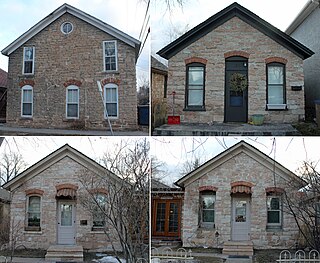
Bath Row, also known as the Theodore Bath Historic District, are four buildings in Laramie, Wyoming, built in 1883 by Theodore Bath and his brothers. The houses were built to be rented to employees of the Union Pacific Railroad. As brother Henry had previously done at the Bath Ranch, Bath Row was built of local limestone with red brick window arches. Three of the houses are single-story shotgun-style houses with a central doorway flanked by narrow windows, extending back from the street. The fourth building is a two-story structure with three windows on the ground floor facing the street, two above, and a round window into the attic. The side windows in all of the buildings align from one building to the next.




















